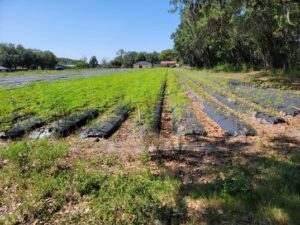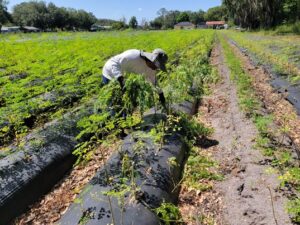Moringa Yield Per Acre
Moringa, also known as the “miracle tree,” has been gaining popularity in recent years due to its numerous health benefits and uses. It is a hardy plant that can grow in various soil types and climates, making it a viable crop for farmers. In this article, we will discuss how to optimize your moringa yield per acre and increase your profits.
What is the moringa yield per acre?
- On average, moringa can produce 4-6 tons of fresh leaves per acre per year.
- Moringa yield per acre can vary depending on several factors such as location, variety, and farming practices.
- With proper soil preparation, fertilization, and irrigation, moringa yield per acre can be increased.
- Yield optimization techniques such as inter-cropping and crop rotation can also help increase moringa yield per acre.
- Record-keeping and monitoring crop growth can help identify areas for improvement and further optimize yield.
Moringa Yield Per Acre: Choosing the Right Variety

When it comes to growing moringa, choosing the right variety is crucial to optimizing your yield per acre. With so many varieties of moringa available, it’s important to select the one that will thrive in your specific location and climate.
Before making a decision, it’s important to understand the characteristics of each variety. Some varieties are better suited for certain climates or soil types, while others may have higher disease resistance or yield potential.
Factors to consider when selecting a variety include yield potential, disease resistance, and growth rate. For example, if you are looking to maximize your yield per acre, you may want to choose a variety that has been bred for high yields. On the other hand, if your growing conditions are prone to certain diseases, you may want to choose a variety with high disease resistance.
It’s also important to consider the intended use of the moringa crop. Different varieties of moringa have varying nutritional profiles, so selecting a variety that aligns with your target market can increase the value of your crop.
Once you have identified the ideal moringa variety for your location and climate, it’s important to source quality seeds or cuttings from a reputable supplier. By choosing the right variety and utilizing high-quality planting materials, you can set your moringa crop up for success and maximize your yield per acre.
Soil Preparation and Fertilization

In order to optimize your moringa yield per acre, it’s essential to prepare your soil properly and provide adequate fertilization. The ideal soil conditions for moringa growth include well-draining soil with a pH range of 6.0 to 7.0.
Before planting, it’s important to conduct soil testing and analysis to determine the nutrient content and pH level of your soil. This can help identify any nutrient deficiencies or imbalances that need to be corrected before planting.
To enhance the fertility of your soil, you can incorporate organic matter such as compost or animal manure. This not only provides essential nutrients to the plants, but also improves soil structure and water-holding capacity.
In addition to organic matter, other fertilizers such as nitrogen, phosphorus, and potassium can be used to enhance moringa growth. It’s important to apply these fertilizers in the right amounts and at the right times to avoid over- or under-fertilization.
Soil conservation practices such as mulching and cover cropping can also help to maintain soil fertility and reduce soil erosion. Mulching involves adding a layer of organic matter to the soil surface, which helps to retain moisture and suppress weed growth. Cover cropping involves planting a non-harvested crop in between moringa rows, which can help to improve soil health and fertility.
By preparing your soil properly and providing adequate fertilization, you can ensure that your moringa crop has the necessary nutrients to thrive and achieve maximum yield per acre.
Optimizing Moringa Yield Per Acre: Planting and Care

Planting and care are crucial factors that can impact the overall yield of your moringa crop. It’s important to understand the optimal time for planting, different planting methods, and care required for moringa plants.
The optimal time for planting moringa depends on your location and climate. Moringa can be planted year-round in areas with consistent temperatures, while in areas with distinct seasons, it’s best to plant during the rainy season.
There are two main planting methods for moringa: direct seeding and transplanting. Direct seeding involves planting moringa seeds directly into the soil, while transplanting involves starting seeds in a nursery and then transplanting the seedlings into the field. Transplanting is typically preferred as it allows for better control of seedling growth and reduces the risk of seedling loss due to pests and environmental factors.
Proper care of moringa plants includes regular pruning to promote branching and increased yield. Pest management is also crucial to prevent damage to the plant and loss of yield. This can be achieved through the use of organic pest control methods such as neem oil and companion planting with pest-repelling plants.
Irrigation and water management are also critical for the successful growth of moringa plants. Moringa requires consistent moisture, but over-watering can lead to root rot and other problems. It’s important to monitor soil moisture levels and adjust irrigation accordingly.
In addition to these basic care practices, moringa plants may also benefit from the use of plant growth regulators and other plant supplements. These can help to promote faster growth and increased yield.
By paying close attention to planting and care practices, you can help to ensure that your moringa crop achieves maximum yield per acre.
Harvesting and Post-Harvest Processing

Harvesting and post-harvest processing are critical stages in the production of moringa leaves. Proper timing and processing can help to maximize your yield and produce high-quality moringa leaf products.
There are two main methods for harvesting moringa leaves: handpicking and mechanical harvesting. Handpicking is the most common method and involves carefully removing the leaves from the tree by hand. Mechanical harvesting, which involves the use of machines, can be more efficient but requires specialized equipment.
Post-harvest processing of moringa leaves involves several steps, including cleaning, shade drying, and packaging. Cleaning involves removing any dirt, debris, or insects from the harvested leaves. Shade drying helps to remove excess moisture and prevent mold growth. After drying, package the leaves for storage or further processing.
Quality control is important throughout the post-harvest process to ensure that the moringa leaf products are of high quality. This can be achieved through careful monitoring and record-keeping of the various processing stages.
People can use Moringa leaf products in various ways, such as taking them as supplements, making teas, and adding them to foods. Proper processing and storage can help to maintain the quality and potency of these products and increase their value in the marketplace.
By paying close attention to the harvesting and post-harvest processing stages of moringa leaf production, you can help to ensure a high yield per acre and produce high-quality moringa leaf products for your customers.
Yield Optimization Techniques

To maximize your moringa yield per acre, there are several techniques you can use:
- Inter-cropping and Crop Rotation: Inter-cropping is the practice of growing two or more crops in the same field at the same time. By inter-cropping moringa with other compatible crops, you can increase your yield per acre and improve soil health. Crop rotation involves planting different crops in the same field in sequential seasons to help reduce pests and diseases and improve soil fertility.
- Record-Keeping and Monitoring Crop Growth: Detailed records aid in yield optimization by tracking planting, testing, fertilization, and harvest data. Monitoring crop growth through regular plant measurements. Such as height and leaf count, can also help you identify any issues early and make necessary changes.
- Utilizing Technology and Precision Farming Practices: Tech improves yield: sensors, drones, and satellites offer data-driven decision-making. Precision farming practices such as variable rate fertilization and irrigation can help you maximize efficiency and reduce waste.
- Pruning: Pruning is the process of removing unwanted parts of the plant to promote healthy growth and increase yield. Prune moringa trees for size, shape, pest control, and leaf growth.
Use these techniques to boost your moringa yield per acre for better profits and sustainable farming. Prioritize sustainable farming for long-term viability and planet health.
In Summary
Growing moringa can be a lucrative and rewarding endeavor. By following the above steps, you can optimize your moringa yield per acre and increase your profits while contributing to a healthier planet. Always prioritize sustainable and responsible farming practices to ensure the long-term success of your operation.
References
- “Moringa: Benefits, side effects, and risks” – https://www.medicalnewstoday.com/articles/319916
- “Moringa oleifera: A Food Plant with Multiple Medicinal Uses” – https://www.ncbi.nlm.nih.gov/pmc/articles/PMC3290775/
Moringa With Barry stores offer a variety of moringa products. These include: Moringa Powder, Moringa Tea, Moringa Capsules and Moringa Oil.
YouTube Video

